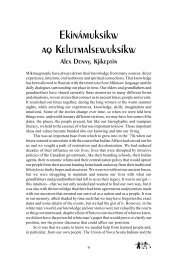The Global Economic Crisis — A Marxist Perspective - Fernwood ...
The Global Economic Crisis — A Marxist Perspective - Fernwood ...
The Global Economic Crisis — A Marxist Perspective - Fernwood ...
Create successful ePaper yourself
Turn your PDF publications into a flip-book with our unique Google optimized e-Paper software.
<strong>The</strong> <strong>Global</strong> <strong>Economic</strong> <strong>Crisis</strong> <strong>—</strong> A <strong>Marxist</strong> <strong>Perspective</strong><br />
period. For a considerable period of time, extending into the 1990s, the<br />
average profit rate was stabilized, albeit in a comparatively low range. Far<br />
more draconian anti-labour measures might have been tried to restore<br />
profitability to higher levels, but such measures would have carried considerable<br />
political-ideological risks <strong>—</strong> particularly during the 1980s, when<br />
the capitalist West was facing down a weakening but still formidable Soviet<br />
adversary.<br />
This was the background to the long ascendancy of the rate of profit in<br />
the U.S. financial sector relative to that of the productive economy (manufacturing,<br />
construction, mining and so forth). In the early 1980s, the financial<br />
sector accounted for only about 10 percent of total profits; by 2007, this<br />
figure had risen to 40 percent. From the 1950s to the 1970s, the ratio of<br />
financial assets to gdp averaged approximately 4 to 1; by 2007 it had risen<br />
to roughly 10 to 1. In 1980, world financial assets (bank deposits, securities<br />
and shareholdings) amounted to 119 percent of global production; by 2007<br />
that figure had risen to 356 percent.<br />
Following the capitalist offensive against labour in the 1970s and early<br />
1980s, crises of overproduction were avoided or attenuated (as in 1991–92<br />
and 2001–02) through an enormous expansion of credit. Between the fourth<br />
quarter of 1981 and that of 2008, credit market debt in the U.S. mushroomed<br />
from 164 percent to 370 percent of gdp. While real wages stagnated or<br />
declined, American working people were encouraged to maintain “effective<br />
demand” by plunging ever deeper into debt. Between 1980 and 2007, total<br />
household debt mushroomed from about 60 percent of national income<br />
to over 120 percent. Meanwhile, between 1973 and 2000, the average real<br />
income of the bottom 90 percent of American taxpayers declined by more<br />
than 7 percent (Chernomas 2009: 21). Ronald Reagan’s massive increase<br />
in military spending during the 1980s, which primed the demand pump<br />
enormously, ran up government debt to unprecedented levels. Throughout<br />
the 1990s, federal government debt continued to steadily expand, before<br />
exploding under George W. Bush following the U.S. invasion and occupation<br />
of Iraq. In early 2009, it stood at about $11 trillion in a $14 trillion (gdp)<br />
economy.<br />
What prompted this massive expansion of debt and the associated<br />
financialization of the U.S. economy? To answer this question, we need to<br />
consider why the traditional, more production-centred investment strategies<br />
Table 1.2: Growth of U.S. National Debt (in constant 2007 dollars), 1945–2009<br />
1945 1950 1990 2000 2008 2009 (projected)<br />
$3 trillion $2 trillion $5 trillion $7 trillion $11 trillion $12 trillion +<br />
9





